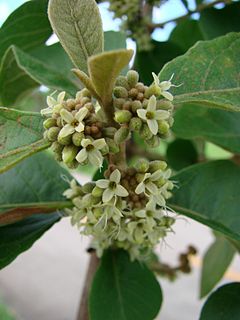
The Lamiaceae or Labiatae are a family of flowering plants commonly known as the mint or deadnettle or sage family. Many of the plants are aromatic in all parts and include widely used culinary herbs like basil, mint, rosemary, sage, savory, marjoram, oregano, hyssop, thyme, lavender, and perilla, as well as other medicinal herbs such as catnip, salvia, bee balm, wild dagga, and oriental motherwort. Some species are shrubs, trees, or, rarely, vines. Many members of the family are widely cultivated, not only for their aromatic qualities, but also their ease of cultivation, since they are readily propagated by stem cuttings. Besides those grown for their edible leaves, some are grown for decorative foliage. Others are grown for seed, such as Salvia hispanica (chia), or for their edible tubers, such as Plectranthus edulis, Plectranthus esculentus, Plectranthus rotundifolius, and Stachys affinis. Many are also grown ornamentally, notably coleus, Plectranthus, and many Salvia species and hybrids.

Tradescantia is a genus of 85 species of herbaceous perennial wildflowers in the family Commelinaceae, native to the Americas from southern Canada to northern Argentina, including the West Indies. Members of the genus are known by many common names, including inchplant, spiderwort, and dayflower.

The Passifloraceae are a family of flowering plants, containing about 750 species classified in around 27 genera.

Tradescantia pallida is a species of spiderwort similar to T. fluminensis and T. zebrina. The cultivar T. pallida 'Purpurea' is commonly called purple secretia, purple-heart, or purple queen. It is native to the Gulf Coast region of eastern Mexico. Edward Palmer collected the type specimen near Ciudad Victoria, Tamaulipas in 1907.

Nyctaginaceae, the four o'clock family, is a family of around 33 genera and 290 species of flowering plants, widely distributed in tropical and subtropical regions, with a few representatives in temperate regions. The family has a unique fruit type, called an "anthocarp", and many genera have extremely large pollen grains.

Tradescantia zebrina, formerly known as Zebrina pendula, is a species of creeping plant in the Tradescantia genus. Common names include silver inch plant and wandering Jew. The latter name is controversial, and some now use the alternative wandering dude. The plant is popular in cultivation due to its fast growth and attractive foliage. It is used as a groundcover in warm winter climates, and as a houseplant elsewhere.

Tradescantia fluminensis is a species of spiderwort native to South America. It is one of several plants known by the common name wandering Jew, but now also commonly called wandering trad. It is also known as small-leaf spiderwort, river spiderwort, inch plant, and wandering willie. The genus is named after the English naturalists and explorers John Tradescant the Elder and John Tradescant the Younger (1608–1662).
Aegiphila mollis is a species of flowering plant in the family Lamiaceae. It is native to Central and South America. Its common names include contra culebra and totumillo.

José Mariano de Conceição Vellozo (1742–1811) was a Colonial Brazilian botanist who catalogued specimens, for example: Cedrela fissilis Vell. in Florae Fluminensis. He was born in Tiradentes, formerly called São José do Rio das Mortes, state of Minas Gerais; and died in Rio de Janeiro, state of Rio de Janeiro. While at the University of Coimbra in Portugal in the 1790s he worked with Martim Francisco Ribeiro de Andrada in translating works on mineralogy and agriculture. The standard author abbreviation Vell. is used to indicate this person as the author when citing a botanical name.

Aegiphila lhotskiana is a species of flowering plant in the family Lamiaceae. It is native to South America, where it occurs in Bolivia and Brazil. This species is cited in Flora Brasiliensis by Carl Friedrich Philipp von Martius.

Aegiphila is a genus of flowering plants in the mint family, Lamiaceae, first described in 1763. It was formerly classified in the Verbenaceae. It is native to Mexico, Central America, South America, the West Indies, and Florida.

Aegiphila ferruginea is a species of flowering plant in the family Lamiaceae. It is endemic to Ecuador. It occurs in the high Andes between 2000 and 4000 meters in elevation, where it grows in cloud forest. There are about 15 wild populations known. It is a shrub or tree that grows easily in disturbed habitat and it can be a common roadside plant in some areas. It is also cultivated on a small scale.
Aegiphila glomerata is a species of flowering plant in the family Lamiaceae. It is endemic to Ecuador, where it has been found at only three locations. It occurs in low-elevation coastal dry forests.
Aegiphila panamensis is a species of flowering plant in the family Lamiaceae. It is native to the Americas, its distribution extending from Mexico to Colombia.
Aegiphila skutchii is a species of flowering plant in the family Lamiaceae. It is native to Guatemala, Honduras, and Mexico.
Aegiphila sordida is a species of flowering plant in the family Lamiaceae. It is endemic to Peru.

Ajugoideae is subfamily of the family Lamiaceae. The subfamily name of Teucrioideae is a synonym of Ajugoideae.
Aegiphila monstrosa is a species of flowering plant in the family Lamiaceae. It is found in Belize, Guatemala, Honduras, and Mexico. It is threatened by loss of habitat to agriculture.

Aegiphila villosa is a species of shrub in the family Lamiaceae. It is native to Guianas and Brazil. It grows primarily in wet tropical biomes.














